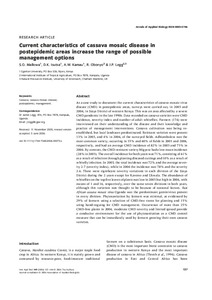| dc.contributor.author | Mallowa, S. |
| dc.contributor.author | Isutsa, D. |
| dc.contributor.author | Kamau, A. |
| dc.contributor.author | Obonyo, R. |
| dc.contributor.author | Legg, J.P. |
| dc.date.accessioned | 2019-12-04T11:18:34Z |
| dc.date.available | 2019-12-04T11:18:34Z |
| dc.date.issued | 2006 |
| dc.identifier.citation | Mallowa, S., Isutsa, D., Kamau, A., Obonyo, R. & Legg, J. (2006). Current characteristics of cassava mosaic in postepidemic areas increase the range of possible management options. Annals of Applied Biology, 149(2), 137-144. |
| dc.identifier.issn | 0003-4746 |
| dc.identifier.uri | https://hdl.handle.net/20.500.12478/3249 |
| dc.description.abstract | As a case study to document the current characteristics of cassava mosaic virus disease (CMD) in post epidemic areas, surveys were carried out, in 2003 and2004, in Siaya District of western Kenya. This was an area affected by a severe CMD pandemic in the late 1990s. Data recorded on cassava varieties were CMD incidence, severity index and number of adult whiteflies. Farmers (174) wereinterviewed on their understanding of the disease and their knowledge andpractice of management interventions. Cassava cultivation was being re-established, but local landraces predominated. Resistant varieties were present13% in 2003, and 4% in 2004, of the surveyed fields. Adhiambolera was the most common variety, occurring in 35% and 40% of fields in 2003 and 2004, respectively, and had an average CMD incidence of 82% in 2003 and 73% in2004. By contrast, the CMD-resistant variety Migyera had a low mean incidence(28% in 2003). The overall incidence for both years was 71%, consisting of 61%as a result of infection through planting diseased cuttings and 10% as a result of whitefly infection. In 2003, the total incidence was 72% and the average severity 2.7 (severity index), while in 2004 the incidence was 78% and the severity2.6. There were significant severity variations in each division of the SiayaDistrict during the 2 years except for Karemo and Ukwala. The abundance of whiteflies on the top five leaves of plants was low in 2003 but high in 2004, with means of 1 and 16, respectively, over the same seven divisions in both years, although this variation was thought to be because of seasonal factors. EastAfrican cassava mosaic virus-Uganda was the predominant geminivirus present in every division. Phytosanitation by farmers was minimal, as evidenced by29% of farmers using a selection of CMD-free stems for planting and 15%using hand-roguing for CMD management. Occurrence of more than 25%CMD-free plants in 2004, moderate CMD severity and limited spread provide a conducive environment for the use of phytosanitation as a CMD control measure that can be immediately used by farmers growing their own cassava varieties. |
| dc.description.sponsorship | Office for United States Foreign Disaster Assistance |
| dc.language.iso | en |
| dc.subject | Cassava |
| dc.subject | Cassava Mosaic Disease |
| dc.subject | Postepidemic |
| dc.subject | Management |
| dc.title | Current characteristics of cassava mosaic in postepidemic areas increase the range of possible management options |
| dc.type | Journal Article |
| dc.description.version | Peer Review |
| cg.contributor.affiliation | Egerton University |
| cg.contributor.affiliation | International Institute of Tropical Agriculture |
| cg.contributor.affiliation | University of Greenwich |
| cg.coverage.region | Africa |
| cg.coverage.region | East Africa |
| cg.coverage.country | Kenya |
| cg.isijournal | ISI Journal |
| cg.authorship.types | CGIAR and developing country institute |
| cg.iitasubject | Cassava |
| cg.iitasubject | Disease Control |
| cg.iitasubject | Plant Production |
| cg.iitasubject | Plant Diseases |
| cg.accessibilitystatus | Limited Access |
| local.dspaceid | 94923 |
| cg.identifier.doi | http://dx.doi.org/10.1111/j.1744-7348.2006.00073.x |

